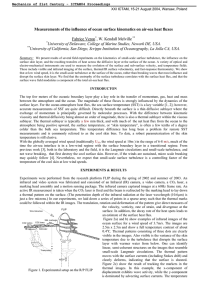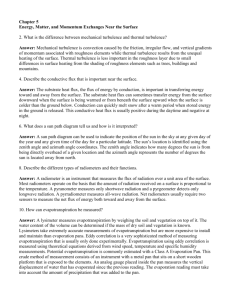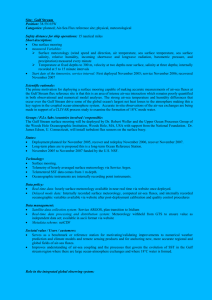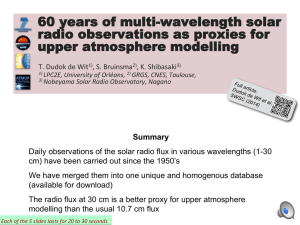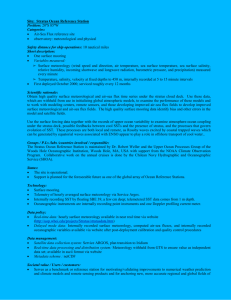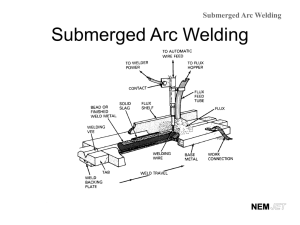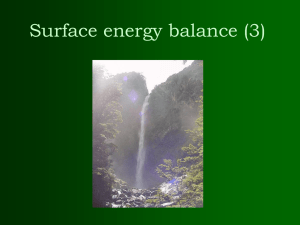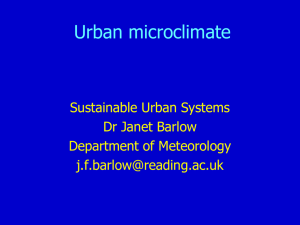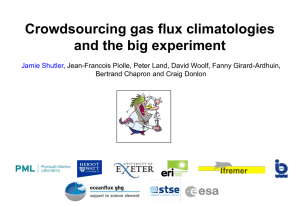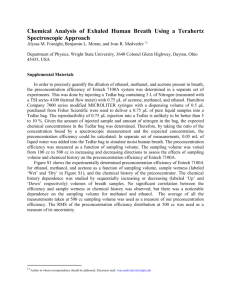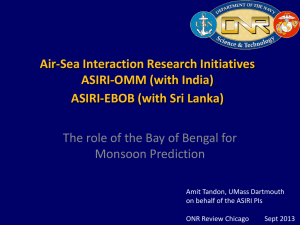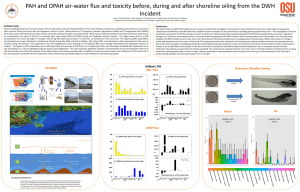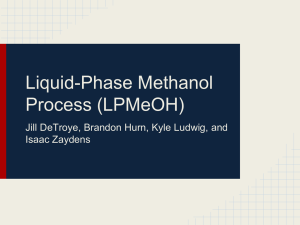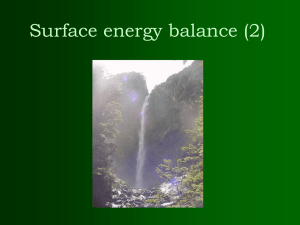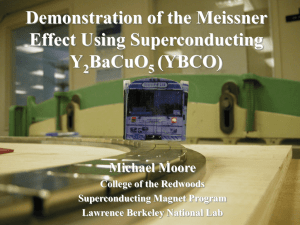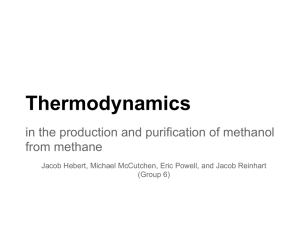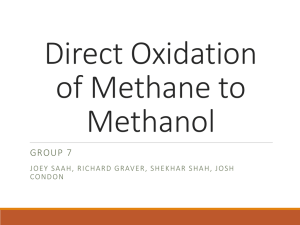Mingxi Yang 1
advertisement
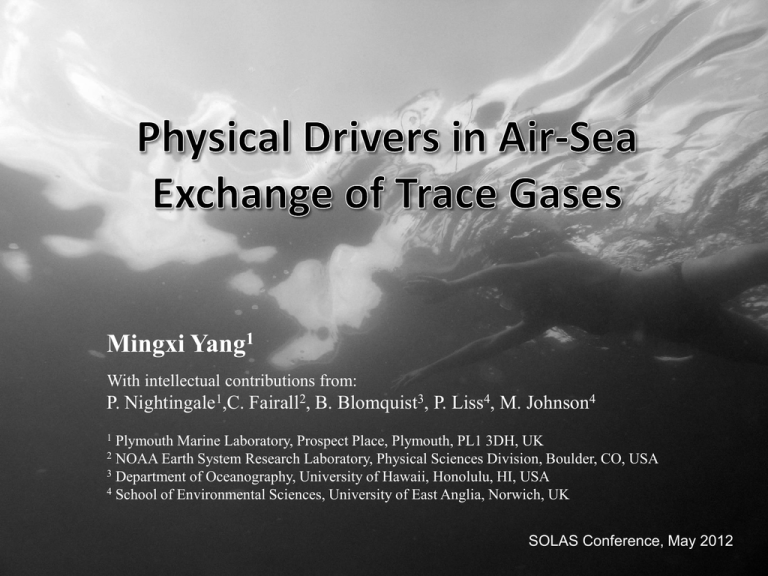
Mingxi Yang1 With intellectual contributions from: P. Nightingale1,C. Fairall2, B. Blomquist3, P. Liss4, M. Johnson4 1 Plymouth Marine Laboratory, Prospect Place, Plymouth, PL1 3DH, UK NOAA Earth System Research Laboratory, Physical Sciences Division, Boulder, CO, USA 3 Department of Oceanography, University of Hawaii, Honolulu, HI, USA 4 School of Environmental Sciences, University of East Anglia, Norwich, UK 2 SOLAS Conference, May 2012 Air-Sea Gas Flux — Bulk Formulation ~F F KC ∆C ~ F : Air-sea flux K : Transfer velocity ∆C : Air-sea concentration difference ~ 1/K Ohm’s Law V = IR Flux is often estimated from ∆C assuming a parameterization of K(U) Climatological Mean ∆pCO2 Question: How does transfer velocity vary with wind speed? Answer(s): Short: Depends on the gas of interest Long: Let’s have a look at the physical processes near the air-sea interface Classic ‘Two-Layer Model’ from Liss & Slater (1974) — Molecular Diffusion Limits Gas Exchange Ca Ca,0 Air Turbulent Transfer Molecular diffusion Ca,0= Cw,0 / Molecular diffusion Water Cw ra 1/ ka rw 1/ k w Ka [ Kw [ Cw,0 1 1 1 ] k a Large k a k w 1 1 ] kw kw ka Small Turbulent Transfer F K a (Ca,0 Ca ) K a (Cw / Ca ) F K w (Cw Cw,0 ) K w (Cw Ca ) Gas Sol () ra / total Methanol 6067 0.96 Acetone 701 0.74 DMS 11.5 0.05 CO2 0.78 <0.01 Schmidt Number Dependence Sc / : Kinematic viscosity : Molecular diffusivity ka Sca kw Scw (α=0.78) (α=11.5) (α=413) (α=701) (α=6067) Total Transfer Velocity from Air Perspective 1/ 2~2 / 3 1/ 2 Predicted K from ka(Sca), kw(Scw), and Estimates from NOAA-COARE Gas Transfer Model (α=0.78) (α=11.5) (α=413) (α=701) (α=6067) Total Transfer Velocity from Water Perspective K a F /(Ca,0 Ca ) F /(Cw Cw,0 ) K w Turbulence Drives Air-sea Transfer by: - Disrupting diffusion layer & Causing Renewal - Increasing turbulent diffusivity Sources of turbulence to surface ocean include… Calm conditions: Buoyancy-driven Instability (sea warmer than air) In moderate winds: Shear stress () In rough seas: Wave breaking (from wind blowing tangentially to sea surface) (wave stress, dissipation, whitecap) U (z) z u*2 A More Realistic Air-sea Interface − Aerodynamic Resistance Important away from Interface Resistance at U10=7 m/s Air NOAA-COARE, Fairall et al 2000 Ca,z ra,t (za ) 1 ln(za /a ) /u*a U(za ) /u*a 2 Turbulence ~120 s/m at za = 10 m δa ~ 1 mm Diffusion & renewal Ca,0 δw ~ 100 m & Cw,0 Diffusion renewal Turbulence Zw Cw,z Modified from Jaehne and Haussecker, 1998 Water ra,m (ha /u*a )Sca1/ 2 ~50 s/m for Sca = 1 rw,m (hw /u*w )Scw1/ 2 ~33000 s/m for Scw = 660 rw,t (zw ) 1 ln(zw / w ) /u*w ~2600 s/m at zw = 5 m Ka 1 1 Ra ra,t ra,m (rw,t rw,m ) / Additional Pathways for Gas Exchange in High Winds • Bubbles Injected (complete dissolution) • Equilibrated (incomplete dissolution) • Not equilibrated (Incomplete dissolution) Flux ~ fwh Ca Stanley et al 2009 Flux ~ fwh ΔC α-1 Woolf 1997 Flux ~ fwh ΔC Scw-m α-n Asher et al 1996; Keeling 1993 Sea spray potentially important for transfer of surface enhanced/reactive gases • HCl McInnes et al 1994 • CH3I Yokouchi et al 2001 • SO2 Sievering et al 1991 How well do we know kw? Numerous Field/Lab Measurements of Different Waterside Controlled Gases, though few in high winds • Fair agreement in low to moderate winds 3He < CO2< DMS • Large divergence among different gases/methods in high winds - Measurement uncertainties & differences - Sea state, bubble effects How well do we know ka? Based only on water transfer and theoretical studies • Wind-wave tunnel measurements higher than model estimates • ka sensitive to height and atmospheric stability • Transfer of (Nonwater) airside controlled gas only measured in lab - No field observation! 10000 Recent Measurements from Circular Wind-Wave Tank Ka (mean) of the Air Side Controlled Tracers Demonstrate Dependence of Ka on , Sc, u* methanol acetone MEK acetaldehyde ethyl acetate Ka (cm/hr) 8000 6000 (a(α=4200) = 4200) (a(α=623) = 623) (a (α=524) = 524) (a = 342) (α=342) (a(α=175) = 175) 4000 2000 Still need field validation for airside controlled gases 0 5 10 15 20 25 30 35 40 45 50 Ua* ( cm/s ) E. Mesarchaki1, J. Williams1, K. Richter2, C. Kräuter2, B. Jähne2 1Max 2Institute Planck Institute for Chemistry in Mainz, Germany for Environmental Physics, University of Heidelberg, Germany 55 60 Latitude 10 Ka from Oxygenated Volatile -30 -20 Organic Compounds (OVOCs: alcohols, ketones, aldehydes..) Produced naturally & anthropogenically • Affect tropospheric chemistry & climate via O3/OH cycling • Utilized by microbes in surface ocean 30 -30 -40 Abundant & soluble • Methanol Flux -10Predicted 0 10 20 -10 in the Atlantic (μmol m-2 day-1) -20 Latitude • 0 -50 Pre-dawn -2 -1 F (umol m day ) Solar Noon Figure from Beale, R. Dissertation, 2011 Concurrent Flux Measurements of Methanol and Acetone with Eddy Covariance Vertical fluxes from the rooftop of Plymouth Marine Laboratory Methanol and acetone quantified by a Proton-Transfer-Reaction Mass Spectrometer (PTR-MS) H3O CH3OH H2O CH 3OH H H3O CD3OH H2O CD3OH H • Use continuous Isotopic standard • Derive ambient [OVOC] from ratio Initial Flux Results Promising Methanol Acetone F W 'C' • Similarity to heat spectrum confirms robustness of OVOC flux measurements • Need uncontaminated flux and seawater [OVOC] to estimate Ka Why are lab measurements not enough? • Different turbulence structure compared to nature - Limited fetch and wall effects - Fixed atmospheric stability • Usually with fresh water - Surface tension - Chemical reactivity - Microlayer enhancement Need field validation for airside controlled gases Near-surface Variability in Microbial Loss of Methanol SOLAS-DOGEE II Cruise 1000 ppt 500 ppt N. Atlantic, U ~ 5 m/s C: Catamaran N: Near Surface Sampling Device Dixon & Nightingale, BGD, 2012 300 ppt
